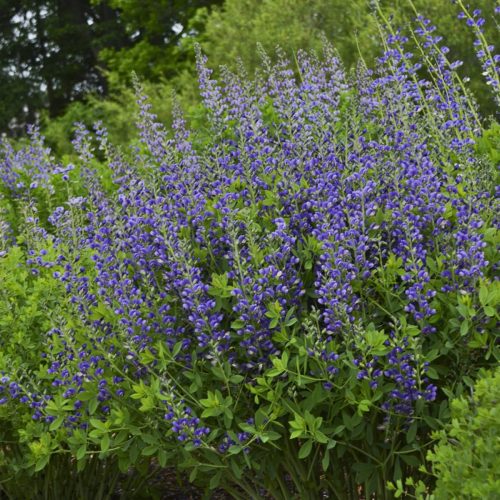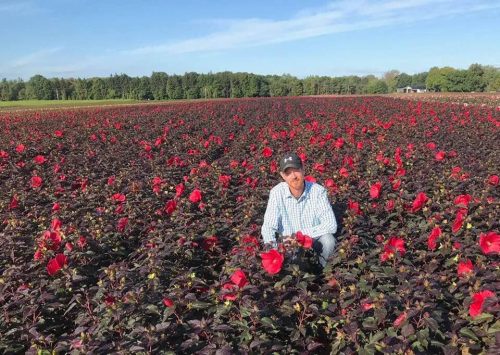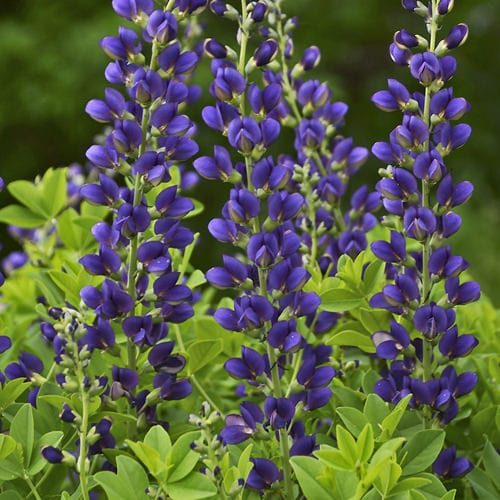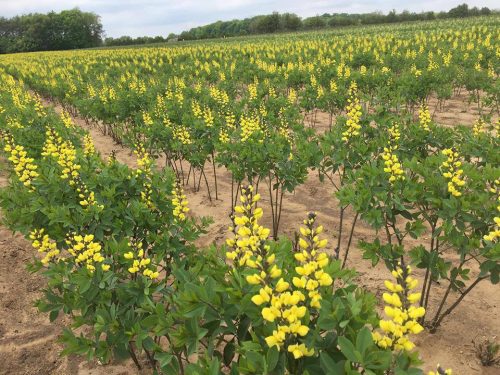If you’ve ever wondered where new plants come from, you’ll enjoy this story behind the Decadence® Baptisia series, developed by renowned plant hybridizer Hans Hansen.
Baptisia, commonly known as false indigo, is quite literally an ancient plant that dates back to the time of the Ancient Egyptians. It’s also a prolific native prairie plant here in North America, with stories of use dating back to indigenous peoples who fashioned the plant’s dried seed pods into baby rattles for their infants.
Hybridizer Hans Hansen, director of new plant development for Walters Gardens and Proven Winners Perennials, is the man behind many of the most popular cultivars of false indigo available today. He shared one of his earliest memories of the plant with us.
“A neighbor lady near my parents’ farm in Minnesota grew Baptisia australis in her garden. When I was seven years old, she moved and told me I could have any plants she left behind. My dad and I tried to dig up her 20 year old clump of Baptisia and broke the handle off our shovel in the process. After a lot of hard work, we finally successfully dug it out and planted it in our own garden. It is still growing there today, over 40 years later. It has outlived both the original owner and my dad.”
Hybridizer Hans Hansen breeds many different kinds of perennials including Baptisia and Hibiscus. Here he is in a field of Summerific® ‘Holy Grail’ rose mallow, another of his many popular introductions. Photo courtesy of Walters Gardens.
The roots of the Decadence® Baptisia series were established more recently, after a botanizing trip in 1997 by Hansen and Tony Avent, owner of Plant Delights Nursery. The men set off into the Great Plains states—places like Kansas, Oklahoma and Texas—to find the best forms of as many native Baptisia species as they could find growing in the wild. They collected cuttings from these plants and brought them back to their nurseries to see what they could make of them.
Hybridizing Goals for Baptisia
Hansen saw tremendous potential in these native plants for a greater diversity in flower colors, bloom times and plant habits. He felt he could make a valuable contribution to the horticulture world by working with them. “In the mind of a plant hybridizer, the best is always yet to come,” said Hansen.
Avent and Hansen decided to develop divergent hybridizing goals on their botanizing trip. Avent would breed for taller varieties with a vase-shaped habit and long flower scapes. Hansen would breed for shorter, more compact varieties in a diverse range of colors, with long flower scapes that stand up above the foliage.
Decadence® ‘Sparkling Sapphires’ Baptisia
As the selection process developed, Hansen also began to breed for plants with foliage that starts low on the stems, lessening the gap between the soil line and the foliage canopy. This last goal has proven to be particularly challenging given that the native species tend to have bare stems about one third of the way up off the ground.
Baptisia Cultivars – A Decade in the Making
After 13 years of continuous crossing and seedling selection, Hansen’s first named varieties were introduced; a few years later, Avent introduced his “Towers” series. Hansen’s work is now sold under the Decadence and Decadence Deluxe series from Proven Winners.
Decadence® Deluxe ‘Pink Truffles’ Baptisia
Native Baptisia species’ generally bloom with blue, white or yellow flowers. Hansen has expanded that range over the last decade by bringing the world’s first pink, maroon, near-black and bicolor selections to market. His favorite introduction to date is Decadence Deluxe ‘Pink Truffles’ because it represents a momentous color break for false indigo—one he had been working towards for over ten years. He also appreciates its majestic habit and long flower spikes that bloom well above the foliage where they can easily be enjoyed by his garden visitors and accessed by pollinating bees and butterflies.
Hansen continues to hybridize false indigo today, with goals of creating even more color diversity, developing later flowering selections and exploring the different foliage types among the species.
Age is a Virtue with Baptisia
Unlike some perennials which can be grown in just a few months, false indigo is an example of the slow horse winning the race. At Walters Gardens in Michigan, false indigo is grown in fields where they are left to mature for 18 months.
Decadence® ‘Lemon Meringue’ Baptisia
is grown for 18 months in the field before it is ready to be dug and potted. Photo courtesy of Walters Gardens.
After 18 months, the plants are dug up and sold in bare root form to growers like Garden Crossings who pots them up and grows them for several more months before they are ready to be sold. The large plants you buy from the nursery have been cared for and grown for a total of nearly two years before you bring them home. Once planted in your garden, you can expect them to live 50 or more years—far longer than most perennials.
Want to see more of this fascinating perennial? Here’s a link to our Baptisia collection






2 thoughts on “The Story Behind the Plant: Decadence® Baptisia”
Are these available
Yes here is a link: https://www.gardencrossings.com/product-category/perennials/false-indigo/